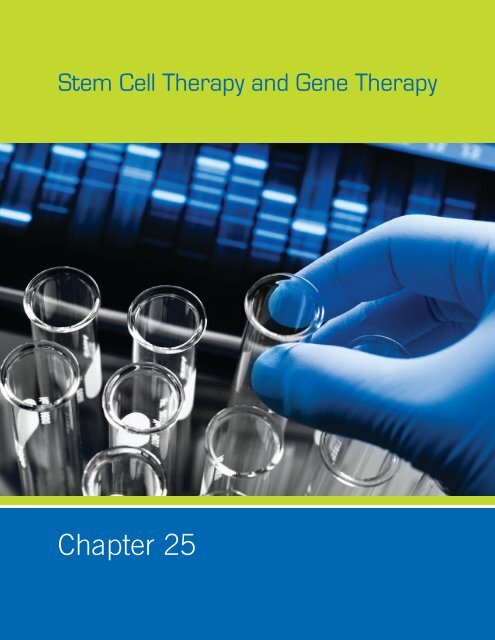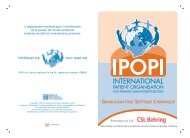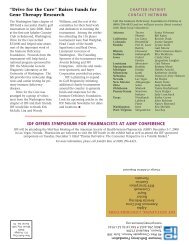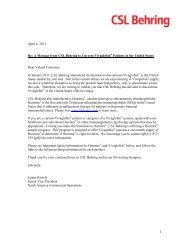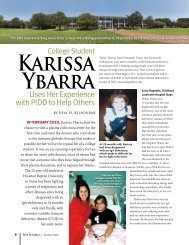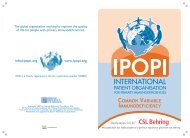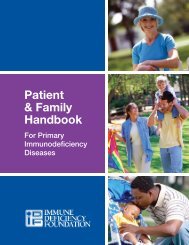Stem Cell Therapy and Gene Therapy
Stem Cell Therapy and Gene Therapy
Stem Cell Therapy and Gene Therapy
Create successful ePaper yourself
Turn your PDF publications into a flip-book with our unique Google optimized e-Paper software.
<strong>Stem</strong> <strong>Cell</strong> <strong>Therapy</strong> <strong>and</strong> <strong>Gene</strong> <strong>Therapy</strong><br />
Chapter 25
<strong>Stem</strong> <strong>Cell</strong> <strong>Therapy</strong> <strong>and</strong> <strong>Gene</strong> <strong>Therapy</strong><br />
Hematopoietic stem cell transplantation (HSCT) represents the mainstay<br />
of treatment for several severe forms of primary immunodeficiency<br />
diseases. Progress in cell manipulation, donor selection, the use of<br />
chemotherapeutic agents, <strong>and</strong> prevention <strong>and</strong> management of transplantrelated<br />
complications has resulted in significant improvement in survival<br />
<strong>and</strong> quality of life after HSCT. In some forms of severe primary<br />
immunodeficiency diseases, gene therapy may represent a valid<br />
alternative for patients who lack acceptable stem cell donors.<br />
Hematopoietic <strong>Stem</strong> <strong>Cell</strong> Transplantation<br />
A “stem cell” is a type of cell that can divide over <strong>and</strong><br />
over <strong>and</strong> produce more stem cells as well as<br />
descendant cells that turn into different types of cells.<br />
Embryonic stem cells, for instance, can make<br />
descendants that turn into any tissue in the body, like<br />
skin cells, brain cells, heart cells etc. For each organ in<br />
the mature body, there are specific stem cells that can<br />
make all the different kinds of cells in that organ. For<br />
example, in the blood system, hematopoietic (“bloodforming”)<br />
stem cells (HSC) give rise to each of the<br />
different types of blood cells such as red blood cells<br />
(RBC), white blood cells (WBC) <strong>and</strong> platelets.<br />
Traditionally, HSCs were obtained from the bone<br />
marrow. This process was called “bone marrow<br />
transplantation.” However, new methods now obtain<br />
HSC from peripheral blood, or blood taken from the<br />
placenta at birth (“cord blood”). Cord blood, in<br />
particular, provides an excellent alternative source of<br />
HSC for the immune <strong>and</strong> blood systems. The process of<br />
taking HSCs from one person <strong>and</strong> transfusing them into<br />
another is called hematopoietic stem cell<br />
transplantation, or HSCT. Unlike transplantation of a<br />
solid organ (such as a kidney or liver), HSCT does not<br />
involve surgery. It is more similar to a blood transfusion.<br />
But instead of just blood, the fluid transfused contains<br />
HSCs.<br />
The primary immunodeficiency diseases for which<br />
HSCT is most commonly performed include Severe<br />
Combined Immune Deficiency (SCID), Wiskott-Aldrich<br />
Syndrome (WAS), IPEX Syndrome, Hemophagocytic<br />
Lymphohistiocytosis (HLH) <strong>and</strong> X-linked<br />
Lymphoproliferative Disease (XLP). It can also be used<br />
in the treatment of Chronic Granulomatous Disease<br />
(CGD) <strong>and</strong> many other severe primary<br />
immunodeficiency diseases. The transplantation of<br />
HSCs from a “normal” individual to an individual with a<br />
primary immunodeficiency disease has the potential to<br />
replace the deficient immune system of the patient with<br />
a normal immune system <strong>and</strong>, thereby, affect a cure.<br />
There are two potential obstacles that must be<br />
overcome for HSCT to be successful. The first obstacle<br />
is that the patient (known as the recipient or host) may<br />
have enough immune function remaining after the<br />
transplant to recognize the transplanted stem cells as<br />
something foreign. The immune system is programmed<br />
to react against things perceived as foreign <strong>and</strong> tries to<br />
reject them. This is called graft rejection. In order to<br />
prevent rejection, most patients require chemotherapy<br />
<strong>and</strong>/or radiation therapy to weaken their own residual<br />
immune system enough to prevent it from rejecting the<br />
transplanted HSCs. This is called “conditioning” before<br />
transplantation. Many patients with SCID have so little<br />
153 | IDF Patient & Family H<strong>and</strong>book
<strong>Stem</strong> <strong>Cell</strong> <strong>Therapy</strong> <strong>and</strong> <strong>Gene</strong> <strong>Therapy</strong><br />
(Hematopoietic <strong>Stem</strong> <strong>Cell</strong> Transplantation continued)<br />
immune function that they are incapable of rejecting a<br />
graft <strong>and</strong> do not require conditioning before HSCT.<br />
A similar situation occurs when the recipient’s bone<br />
marrow is full of its own, defective stem cells <strong>and</strong> the<br />
HSC cannot find anyplace to establish themselves. This<br />
is called “failure of engraftment.” To prevent this,<br />
chemotherapy may be given to reduce the number of<br />
defective HSC in the recipient’s bone marrow in order to<br />
“make room” for the new HSC to engraft.<br />
Although the chemotherapy treatment prevents the host<br />
from rejecting the transplanted HSCs, it may cause<br />
serious side effects. These include transient loss of all of<br />
the cells of the bone marrow so the patient is very<br />
susceptible infections, anemia (low RBC) <strong>and</strong> bleeding<br />
problems due to low platelets. Chemotherapy also may<br />
cause severe blistering of the mouth or other mucous<br />
membranes that makes getting adequate hydration <strong>and</strong><br />
nutrition very difficult. It is because of these serious<br />
complications that HSCT is reserved for those patients<br />
with the most severe immune defects.<br />
The second obstacle that must be overcome for the<br />
transplant to be successful is Graft versus Host Disease<br />
(GVHD). This occurs when the mature T-cells from the<br />
donor or which develop after the transplant, perceive<br />
the host’s tissues as foreign <strong>and</strong> attack these tissues. To<br />
prevent GVHD, medications to suppress inflammation<br />
<strong>and</strong> T-cell activation are used. These medications may<br />
include steroids, cyclosporine <strong>and</strong> other drugs.<br />
In order to prevent some of these potential obstacles, it<br />
is important to try to identify a “matched” donor. A<br />
matched donor is one whose Human Leukocyte<br />
Antigens (HLA) are the same as those of the recipient.<br />
Selecting a Donor<br />
HLA are tissue types. Each of us has our own<br />
collection of HLA antigens on our cells including the<br />
cells of our immune system <strong>and</strong> bone marrow, as well<br />
as on cells in most other tissues <strong>and</strong> organs. The<br />
exact structure of these HLA antigens is determined<br />
by a series of genes clustered on the sixth (6th)<br />
human chromosome. Compatibility of HLA is very<br />
important to determine the chance of successful<br />
engraftment while keeping the risk of GVHD low.<br />
There are many different variants for each of these<br />
HLA genes in humans. The combination of HLA alleles<br />
of each individual is relatively unique. However, since<br />
the HLA genes are closely clustered on chromosome<br />
6, they are usually inherited as a single unit.<br />
Therefore, the chance that an individual’s brother or<br />
sister shares the same HLA alleles is relatively high.<br />
There is a 1 in 4 chance that any sibling could be a<br />
perfect match for the patient. Unfortunately, due to the<br />
laws of probability <strong>and</strong> the fact that most families have a<br />
limited number of children, fewer than 25% of patients<br />
have a sibling who is a “match.” Therefore, there has<br />
been a major effort to develop alternative methods to<br />
offer the possibility of a transplant to patients who do<br />
not have a matched donor in their own family.<br />
One alternative is to try to find a suitable matched donor<br />
through one of the worldwide computer-based registries<br />
of individuals who have volunteered to serve as bone<br />
marrow donors. The National Marrow Donor Program in<br />
the U.S. has listings of hundreds of thous<strong>and</strong>s of<br />
individuals who have provided a blood sample to have<br />
their HLA type measured. Similar registries are present<br />
in many countries around the world.<br />
IDF Patient & Family H<strong>and</strong>book | 154
<strong>Stem</strong> <strong>Cell</strong> <strong>Therapy</strong> <strong>and</strong> <strong>Gene</strong> <strong>Therapy</strong><br />
(Selecting a Donor continued)<br />
Information on the combination of HLA alleles of more<br />
than 19 million volunteer donors is collected in Bone<br />
Marrow Donors Worldwide (BMDW). This database can<br />
be easily accessed by authorized healthcare<br />
professionals to explore the possibility that there is a<br />
matched unrelated donor (MUD) available for a patient<br />
who needs HSCT <strong>and</strong> does not have an HLA-matched<br />
donor in the family.<br />
Successful transplants for patients with a primary<br />
immunodeficiency disease using donors found through<br />
this worldwide registry have saved the lives of many<br />
patients over the past 20 years. Results of<br />
transplantation using fully matched unrelated donors for<br />
some diseases now approaches the success rate for<br />
transplants using sibling matches.<br />
Another source of HSC used for transplantation in<br />
patients with primary immunodeficiency diseases is<br />
umbilical cord blood. In the growing fetus, HSC<br />
frequently leave the marrow <strong>and</strong> are found circulating in<br />
high numbers in the blood. At the time of birth, the<br />
placenta can be recovered, the blood that is remaining<br />
removed <strong>and</strong> the HSC isolated <strong>and</strong> banked. These cord<br />
blood HSC may then be HLA typed <strong>and</strong> used for<br />
transplantation. Since cord blood contains fewer mature<br />
T-lymphocytes than the marrow or blood of adult<br />
donors, sometimes cord blood transplants have been<br />
successful even though the degree of match between<br />
donor <strong>and</strong> patient was not very good. One limitation of<br />
cord blood HSC transplantation is that because of the<br />
limited volume of umbilical cord blood, there may not be<br />
a sufficient numbers of HSC to treat a larger child or<br />
adult.<br />
If a perfect match cannot be identified, it is sometimes<br />
possible to use one of the parents as a donor. Either<br />
parent has half of the same alleles as the patient; the<br />
parent is said to be “haploidentical” to the patient.<br />
There are some problems that can occur with this type<br />
of transplant. The mature T-lymphocytes contained in<br />
the bone marrow of the haploidentical parent would be<br />
able to recognize the HLA alleles that are unique to the<br />
patient, <strong>and</strong> would thus cause GVHD.<br />
In order to prevent this complication, it is essential to<br />
remove the mature T-lymphocytes (called T-cell<br />
depletion) from the bone marrow before infusing the<br />
stem cells into the patient. This is done with a<br />
preparative regimen before the transplant. After the<br />
mature T-cells are removed from the HSC, the risk of<br />
GVHD is markedly reduced.<br />
T-lymphocytes of donor origin that develop from the<br />
transplanted HSC <strong>and</strong> reconstitute the patient’s<br />
T-lymphocyte immunity will remain haploidentical to the<br />
rest of the cells of the patient. However, the risk of<br />
GVHD from these T-lymphocytes is low because these<br />
cells develop inside the new host from immature<br />
precursor cells in the grafted marrow. Like a person’s<br />
own T-cells, they are “educated” during their maturation<br />
to ignore or “tolerate” the cells <strong>and</strong> tissues of the host.<br />
It may take as long as six to eight months for the stem<br />
cells to reconstitute T-lymphocytes <strong>and</strong> for these newly<br />
generated T-cells to mature <strong>and</strong> learn to work with other<br />
cells in the host. Therefore, restoration of immune<br />
function after T-cell depleted HSCT takes longer than<br />
after fully matched HSCT (where mature T-lymphocytes<br />
contained in the graft may immediately provide some<br />
immune function).<br />
Sometimes, complete immunologic reconstitution may<br />
not occur after HSCT. In some cases after haploidentical<br />
T-cell depleted HSCT, more than one transplant has to<br />
be performed to achieve T-cell reconstitution. Full<br />
immune reconstitution (including antibody production)<br />
is achieved less often than after fully matched<br />
transplantation.<br />
Some centers use T-cell depleted HSCT for treatment of<br />
babies with SCID who do not have a matched family<br />
donor, while other centers believe that the search for a<br />
155 | IDF Patient & Family H<strong>and</strong>book
<strong>Stem</strong> <strong>Cell</strong> <strong>Therapy</strong> <strong>and</strong> <strong>Gene</strong> <strong>Therapy</strong><br />
(Selecting a Donor continued)<br />
matched unrelated donor is the best first choice option.<br />
The best choice depends on many factors including:<br />
• The type of SCID or primary immunodeficiency<br />
disease<br />
• How much immune function remains<br />
• The degree of matching of potential donors<br />
• The types of HSCT available (cord blood vs.<br />
bone marrow)<br />
• The age of the patient<br />
• How sick they are <strong>and</strong> what types of<br />
complications they have had<br />
Procedures<br />
HSC are “harvested” from the donor by removing bone<br />
marrow from the pelvic bones. Bone marrow is removed<br />
by drawing the marrow up through a needle that is<br />
about 1/8 of an inch in diameter. Only two teaspoons<br />
are taken from each puncture site because, if more is<br />
taken, the sample is diluted with the blood that flows<br />
through the bone marrow space. Bringing blood with the<br />
bone marrow increases the risk of the sample carrying<br />
the mature T-cells that have the potential to cause<br />
GVHD.<br />
Usually, two teaspoons are taken for each two pounds of<br />
the recipient’s body weight. The average donor might<br />
have only a few punctures performed to get enough<br />
stem cells for a baby, but more than 100 punctures may<br />
be required to get enough stem cells for a teen or full<br />
sized adult. The procedure may be performed under<br />
general anesthesia or under spinal anesthesia. The<br />
discomfort after the procedure varies from donor to<br />
donor.<br />
Almost all donors will require some type of pain control<br />
medication for two to three days after the procedure, but<br />
most donors are not required to stay in the hospital<br />
overnight <strong>and</strong> are able to return to full activity shortly<br />
afterwards. The donor’s immune system is not<br />
compromised because HSC <strong>and</strong> marrow quickly<br />
regenerate.<br />
Once it has been harvested, the bone marrow is passed<br />
through a fine sieve to remove any small particles of<br />
bone <strong>and</strong> processed further, if necessary, to remove<br />
incompatible red blood cells, or to remove T-cells. It is<br />
then placed into a sterile plastic bag <strong>and</strong> infused into<br />
the host intravenously just like a blood transfusion.<br />
As an alternative to bone marrow harvesting, HSC can<br />
be obtained from peripheral blood <strong>and</strong> then purified via<br />
a process known as apheresis. The donor’s blood is<br />
collected from an arm vein, using a needle that is<br />
connected with a machine that removes the white blood<br />
cells. After white blood cells are removed from the<br />
blood, the remaining red blood cells are then returned<br />
to the donor via a vein in the opposite arm. The HSC are<br />
then purified from the other white blood cells. Typically,<br />
in order to enrich the amount of HSC in peripheral<br />
blood, the donor receives subcutaneous injections of<br />
granulocyte-colony stimulating factor (G-CSF) or of<br />
plerixafor in the days that precede the blood collection.<br />
Both G-CSF <strong>and</strong> plerixafor mobilize the HSC from the<br />
bone marrow, transferring them into peripheral blood, so<br />
that a large number of HSC are present in the<br />
peripheral blood before the apheresis procedure.<br />
IDF Patient & Family H<strong>and</strong>book | 156
<strong>Stem</strong> <strong>Cell</strong> <strong>Therapy</strong> <strong>and</strong> <strong>Gene</strong> <strong>Therapy</strong><br />
Results of HSCT<br />
HSCT between HLA matched siblings has been<br />
successfully employed in the treatment of primary<br />
immunodeficiency diseases since 1968. The first child<br />
to receive a transplant (a patient with X-SCID) is still<br />
alive, healthy <strong>and</strong> has a family of his own. This case<br />
suggests that, as best as can be determined, the graft is<br />
very long lasting <strong>and</strong> appears to be permanent.<br />
In the case of infants with SCID, HSCT involving a<br />
matched marrow has minimal graft versus host disease<br />
risk <strong>and</strong> is associated with an overall success rate of as<br />
high as 90%. Results of HSCT from unrelated donors<br />
from a haploidentical parent are not as good, yet<br />
approximately 60-80% of the infants survive <strong>and</strong><br />
demonstrate robust T-cell reconstitution.<br />
The chance of survival depends on the health of the<br />
patient at the time of the transplant. If the patient is in<br />
relatively good health, free from infection at the time of<br />
the transplantation <strong>and</strong> does not have lung damage<br />
from previous infections, the outlook is very good.<br />
Because of this, survival is very good (>90%) in infants<br />
with SCID who receive HSCT within 3-4 months of age,<br />
even when the donor is not a family match. This<br />
emphasizes the importance of early recognition of SCID,<br />
<strong>and</strong> the benefit of newborn screening for this disease,<br />
that is BEFORE the patient has a serious infection.<br />
While reconstitution of the number <strong>and</strong> function of T-<br />
lymphocytes is the rule after HSCT for SCID,<br />
normalization of antibody production occurs in some,<br />
but not all, patients. Reconstitution of antibody<br />
production after HSCT for SCID depends on the specific<br />
form of SCID, on the type of donor (matched vs.<br />
haploidentical) <strong>and</strong> on the use of chemotherapy as part<br />
of the preparative regimen before the HSCT. If antibody<br />
production is not reconstituted after HSCT, patients will<br />
require Ig replacement therapy indefinitely to help<br />
protect them from infection. Even if replacement therapy<br />
is required, these patients usually enjoy a good quality<br />
of life after transplant.<br />
HSCT is also an effective form of treatment for other<br />
forms of primary immunodeficiency diseases, including<br />
WAS, IPEX, HLH), XLP, X-linked hyper-IgM (also known<br />
as CD40 lig<strong>and</strong> deficiency), CGD <strong>and</strong> other primary<br />
immunodeficiency diseases.<br />
In most of these conditions, conditioning with<br />
chemotherapy is required before the transplant to allow<br />
engraftment of donor-derived stem cells, even when the<br />
donor is a matched sibling. The success rate after HSCT<br />
from an unrelated donor in these cases is nearly as<br />
good (70-80% survival) as using a matched sibling for<br />
the donor. Here again, the initial health of the patient is<br />
extremely important <strong>and</strong> the best survival rates are in<br />
children who are transplanted under the age of 5, who<br />
are relatively free of infections <strong>and</strong> who do not have preexisting<br />
lung or liver damage.<br />
Mixed chimerism (that is persistence of the patient’s<br />
immune cells along with donor-derived white blood<br />
cells) after HSCT is sufficient to cure the disease in<br />
many of these disorders (IPEX, HLH, XLP, X-linked<br />
hyper-IgM, CGD), <strong>and</strong> this may allow doctors to use less<br />
intense chemotherapy, thus also reducing the risk of<br />
related toxicity. In boys with WAS, mixed chimerism is<br />
associated with a higher risk of complications<br />
(autoimmunity, persistence of low platelets) <strong>and</strong> more<br />
intense chemotherapy regimens are typically used for<br />
this disease.<br />
HSCT is not always indicated in patients with CD40<br />
lig<strong>and</strong> deficiency <strong>and</strong> CGD, as many of these patients<br />
do well on medical management. The risks <strong>and</strong> benefits<br />
of the procedure must always be carefully weighed.<br />
It must be noted that HSCT from a haploidentical parent<br />
is not as successful in primary immunodeficiency<br />
diseases other than SCID <strong>and</strong> is typically reserved to<br />
very severe cases that cannot be safely managed<br />
otherwise. Again the risks <strong>and</strong> benefits must be carefully<br />
addressed.<br />
157 | IDF Patient & Family H<strong>and</strong>book
<strong>Stem</strong> <strong>Cell</strong> <strong>Therapy</strong> <strong>and</strong> <strong>Gene</strong> <strong>Therapy</strong><br />
<strong>Gene</strong> <strong>Therapy</strong><br />
Most primary immunodeficiency diseases are caused by<br />
errors (mutations) in specific genes. It has long been the<br />
hope that one day it would be possible to cure these<br />
diseases by fixing the mutation that causes the disease<br />
<strong>and</strong> thus affect a cure. As a result of the human<br />
genome project <strong>and</strong> similar efforts to map all of the<br />
genes present in human beings, we now know the<br />
identities of the specific genes involved in many<br />
diseases, including the vast majority of primary<br />
immunodeficiency diseases. More genes are being<br />
identified nearly every week. We have finally reached the<br />
stage where that long held hope is becoming a reality.<br />
Not every genetic disorder, including some primary<br />
immunodeficiency diseases, will eventually be<br />
correctable by gene therapy. However primary<br />
immunodeficiency diseases, as a general rule, may be<br />
better suited for this therapy than almost any other class<br />
of genetic disease. Transplantation of HSC taken from a<br />
normal donor has been successful in curing many of<br />
these disorders, so it should theoretically also be<br />
possible to take the patient’s own HSC <strong>and</strong> correct the<br />
genetic defect in those cells by adding a normal copy of<br />
the gene that is causing the disease.<br />
To introduce the gene, we take advantage of the ability<br />
of some viruses (retroviruses) to penetrate into cells <strong>and</strong><br />
to insert their genome into the patient’s own DNA. For<br />
the purpose of gene therapy, viruses have been<br />
modified so that their own genes have been largely<br />
removed <strong>and</strong> replaced with the normal copy of the<br />
defective human gene that is causing the primary<br />
immunodeficiency diseases.<br />
To perform gene therapy, the patient’s HSCs are first<br />
isolated from the bone marrow or from peripheral blood,<br />
<strong>and</strong> they are then cultured in the laboratory with the<br />
virus containing the gene of interest. Various growth<br />
factors are added to the culture to make HSC proliferate<br />
<strong>and</strong> to facilitate infection with the virus. After two to four<br />
days, the cultured cells are washed to remove any free<br />
virus, <strong>and</strong> then they are transfused into the patient. The<br />
cells that have incorporated the gene of interest into<br />
their chromosomes will pass it to all cells that will be<br />
generated when these cells divide. Because the gene<br />
has been inserted into HSC, the normal copy of the<br />
gene will be passed to all blood cell types, but not to<br />
other cells of the body. Because primary<br />
immunodeficiency diseases are caused by gene defects<br />
that affect blood cells, this can be sufficient to cure the<br />
disease.<br />
<strong>Gene</strong> therapy represents a life-saving alternative for<br />
those patients with severe forms of primary<br />
immunodeficiency diseases, who do not have a<br />
matched sibling donor. In these cases, performing an<br />
HSCT from a haploidentical parent or even from a MUD<br />
would carry some significant risks of GVHD. In contrast,<br />
GVHD is not a problem after gene therapy, because in<br />
this case the normal copy of the gene is inserted into<br />
the patient’s own HSC, negating the need for a HSC<br />
donor.<br />
Until now, gene therapy has been used to treat patients<br />
with SCID secondary to adenosine deaminase (ADA)<br />
deficiency, X-linked SCID, CGD <strong>and</strong> WAS. The first<br />
clinical trial of gene therapy was at the National<br />
Institutes of Health in 1990 <strong>and</strong> treated a 4-year-old girl<br />
with ADA deficiency. The design of this first trial did not<br />
attempt to correct the defective HSC, only the T-cells.<br />
This girl is now clinically well <strong>and</strong> still has about 25% of<br />
her circulating T-cells carrying the corrected ADA gene<br />
more than 20 years after her treatment. After this initial<br />
clinical trial demonstrated that gene therapy could be<br />
carried out safely <strong>and</strong> that gene-corrected T-cells could<br />
survive for years <strong>and</strong> function normally, follow up trials<br />
were initiated attempting to cure children with<br />
ADA-SCID by targeting HSC for gene correction. The<br />
results have been spectacular with most of the more<br />
than two dozen ADA-SCID patients attaining a significant<br />
long lasting increase of the T- <strong>and</strong> B-lymphocyte count<br />
IDF Patient & Family H<strong>and</strong>book | 158
<strong>Stem</strong> <strong>Cell</strong> <strong>Therapy</strong> <strong>and</strong> <strong>Gene</strong> <strong>Therapy</strong><br />
(<strong>Gene</strong> <strong>Therapy</strong> continued)<br />
<strong>and</strong> a remarkable improvement of immune function.<br />
Importantly, no episodes of serious adverse reactions or<br />
cases of leukemia have occurred in the patients with<br />
ADA deficiency treated by gene therapy.<br />
The next primary immunodeficiency disease to be<br />
treated by gene therapy was X-linked SCID. This trial<br />
also targeted the HSC using a retrovirus to deliver the<br />
gene. Beginning with a groundbreaking study in Paris<br />
followed by a similar experience in London, there have<br />
been 20 X-SCID babies around the world that have been<br />
treated with gene therapy. In these infants, gene therapy<br />
was performed without any need for chemotherapy prior<br />
to the transfusion of HSC that had been cultured with<br />
the virus. Eighteen of these patients are currently alive,<br />
<strong>and</strong> in 17 of these 18 children gene therapy alone was<br />
sufficient to restore development of T-lymphocytes <strong>and</strong><br />
immune function <strong>and</strong> no other treatment was needed.<br />
<strong>Gene</strong> therapy trials are ongoing with patients with other<br />
primary immunodeficiency diseases. Overall, the<br />
experience with gene therapy in primary<br />
immunodeficiency diseases has demonstrated that it is<br />
possible to cure the disease by inserting a normal copy<br />
of the gene into the patient’s HSC. However, there are<br />
some risks that need to be overcome <strong>and</strong> safer vectors<br />
need to be developed. Various laboratories around the<br />
world are working at modifications of the viral vectors in<br />
order to improve their safety. Nevertheless, gene therapy<br />
must still be regarded as an experimental therapy. It is<br />
likely that the inherent problems will be worked out in<br />
the coming years <strong>and</strong> that a larger number of primary<br />
immunodeficiency diseases will be cured by gene<br />
therapy.<br />
Unfortunately, while the SCID was cured, five of these<br />
patients developed leukemia. Four of the children’s<br />
leukemia was cured, but one child died.<br />
159 | IDF Patient & Family H<strong>and</strong>book


